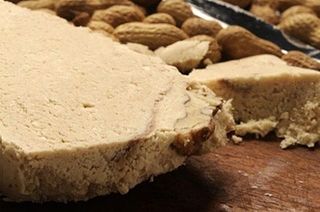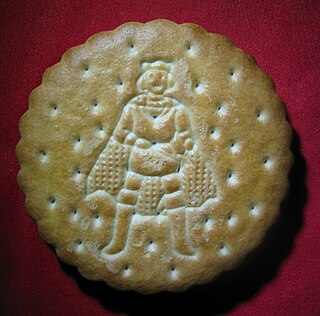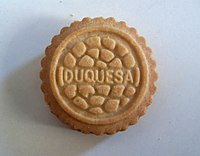
Oreo is a brand of sandwich cookie consisting of two cocoa biscuits or cookie pieces with a sweet fondant filling. It was introduced by Nabisco on March 6, 1912, and through a series of corporate acquisitions, mergers and splits both Nabisco and the Oreo brand have been owned by Mondelez International since 2012. Oreo cookies are available in over one hundred countries. Many varieties of Oreo cookies have been produced, and limited-edition runs have become popular in the 21st century.

Nabisco is an American manufacturer of cookies and snacks headquartered in East Hanover, New Jersey. The company is a subsidiary of Illinois-based Mondelēz International.

Newtons are a Nabisco-trademarked version of a pastry filled with sweet fruit paste. "Fig Newtons" are the most popular variety. They are produced by an extrusion process. Their distinctive shape is a characteristic that has been adopted by competitors, including generic fig bars sold in many markets.

Filipinos is the brand name for a series of biscuit doughnut snacks made by Mondelez International. In France, Spain, Portugal and the Nordic countries they are produced and sold under the 'Artiach' brand name. Under license to United Biscuits, in the Netherlands they are sold and produced locally under the Verkade brand. They have drawn controversy for having the same name as the people of the Philippines.

General Foods Corporation was a company whose direct predecessor was established in the United States by Charles William Post as the Postum Cereal Company in 1895.

Milka is a Swiss brand of chocolate confectionery, originally made in Switzerland in 1901 by Suchard. It has then been produced in Lörrach, Germany from 1901. Since 2012 it has been owned by US-based company Mondelez International, when it started following the steps of its predecessor Kraft Foods Inc., which had taken over the brand in 1990. It is sold in bars and a number of novelty shapes for Easter and Christmas. Products with the Milka brand also include chocolate-covered cookies and biscuits.

Stella D'oro is an American brand of cookies and breadsticks owned by Snyder's-Lance. Stella D'oro means "star of gold" in Italian, and the cookies are inspired by Italian baking. Its products include breadsticks, Swiss Fudge and other cookies, biscotti, and their S-shaped breakfast treats.

Kraft Foods Inc. was a multinational confectionery, food and beverage conglomerate. It marketed many brands in more than 170 countries. 12 of its brands annually earned more than $1 billion worldwide: Cadbury, Jacobs, Kraft, LU, Maxwell House, Milka, Nabisco, Oreo, Oscar Mayer, Philadelphia, Trident, and Tang. Forty of its brands were at least a century old.

Lefèvre Utile, better known worldwide by the initials LU, is a French manufacturer brand of biscuits, emblematic of the city of Nantes. The brand is now part of US confectionery company Mondelēz International since 2012, after splitting of its previous owner Kraft Foods Inc., which had acquired it as part of its acquisition from Groupe Danone in 2007. The Petit-Beurre biscuit remains the flagship product alongside the Ladyfinger, Champagne, Petit four, Prince de LU, Pim's, Paille d'Or, etc.

Nilla is a brand name owned by Nabisco that is most closely associated with its line of vanilla-flavored, wafer-style cookies. The name is a shortened version of vanilla, the flavor profile common to all Nilla-branded products. Originally sold as Nabisco Vanilla Wafers, the product's name was changed in 1967 to the abbreviated form Nilla Wafer.

Irene Blecker Rosenfeld is an American businesswoman who was the chairman and chief executive officer (CEO) of Mondelēz International. Rosenfeld's career began at Dancer Fitzgerald Sample, a New York City advertising agency. She later joined General Foods consumer research, and then led Frito-Lay as CEO and chairwoman.

Mantecol is the brand name of a typical dessert of the cuisine of Argentina, a sort of semi-soft nougat made from peanut butter. It was originally created and marketed in the 1940s by the confectionery company Georgalos, founded by a Greek immigrant, Miguel Georgalos, who took the inspiration in a dessert of Greek cuisine, the halva.

Mondelez International, Inc., styled as Mondelēz International, is an American multinational confectionery, food, holding, beverage and snack food company based in Chicago. Mondelez has an annual revenue of about $26 billion and operates in approximately 160 countries. It ranked No. 108 in the 2021 Fortune 500 list of the largest United States corporations by total revenue.

Belvita, sometimes stylized as belVita or BelVita, is a brand of breakfast biscuit introduced originally in France in 1998 as LU Petit Déjeuner by Kraft Foods Inc. and currently owned by Mondelēz International.

Borio is a brand of biscuits local to Egypt that is similar to Oreo. It consists of two chocolate biscuits with creme filling in between.

Prince de LU (Prince) is a biscuit brand made by the enterprise Mondelez International.

Fontaneda is a Spanish food sector company dedicated to the manufacture of crackers and biscuits. At its height, between 1950 and 1975, Fontaneda had yearly revenues of more than 10 billion pesetas.

Trakinas is a Brazilian sandwich cookie brand originally created by the Nabisco company in 1988. The product is known for being mainly focused on children and consists of two biscuits with a sweet crème filling, with the difference that each cookie is modeled in the shape of a face with two holes for the eyes and one for the mouth.

Bagley Argentina S.A. is an Argentine food company with its main plant located in Buenos Aires. Established by U.S.-born entrepreneur Melville Sewell Bagley in 1864, the company had a wide variety of brands, having specialised in the production of crackers and cookies.





















